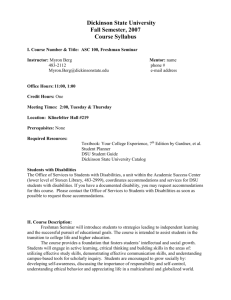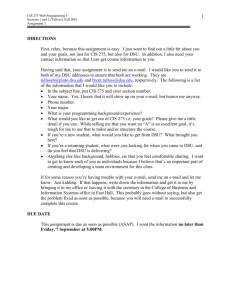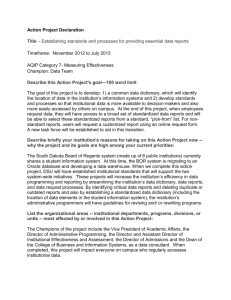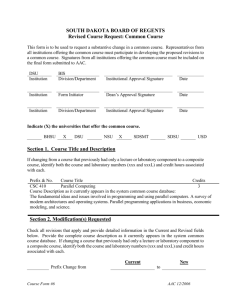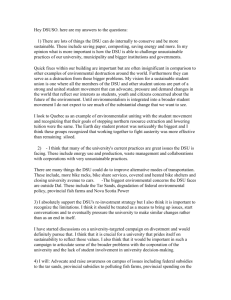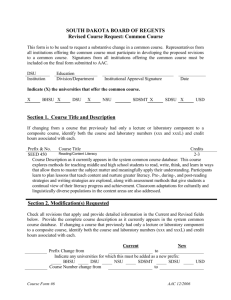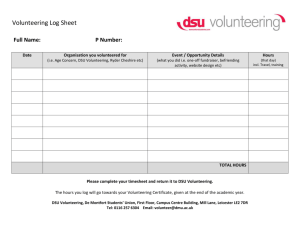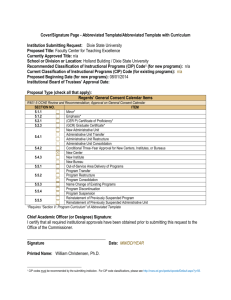Update/Review
advertisement
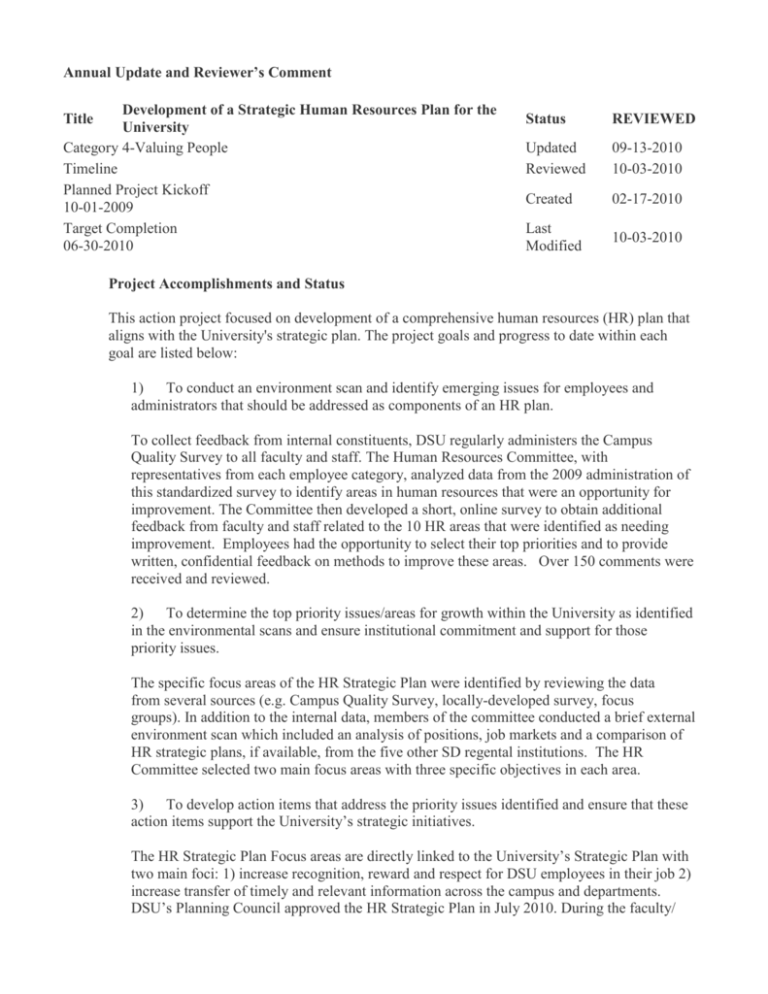
Annual Update and Reviewer’s Comment Development of a Strategic Human Resources Plan for the University Category 4-Valuing People Timeline Planned Project Kickoff 10-01-2009 Target Completion 06-30-2010 Title Status REVIEWED Updated Reviewed 09-13-2010 10-03-2010 Created 02-17-2010 Last Modified 10-03-2010 Project Accomplishments and Status This action project focused on development of a comprehensive human resources (HR) plan that aligns with the University's strategic plan. The project goals and progress to date within each goal are listed below: 1) To conduct an environment scan and identify emerging issues for employees and administrators that should be addressed as components of an HR plan. To collect feedback from internal constituents, DSU regularly administers the Campus Quality Survey to all faculty and staff. The Human Resources Committee, with representatives from each employee category, analyzed data from the 2009 administration of this standardized survey to identify areas in human resources that were an opportunity for improvement. The Committee then developed a short, online survey to obtain additional feedback from faculty and staff related to the 10 HR areas that were identified as needing improvement. Employees had the opportunity to select their top priorities and to provide written, confidential feedback on methods to improve these areas. Over 150 comments were received and reviewed. 2) To determine the top priority issues/areas for growth within the University as identified in the environmental scans and ensure institutional commitment and support for those priority issues. The specific focus areas of the HR Strategic Plan were identified by reviewing the data from several sources (e.g. Campus Quality Survey, locally-developed survey, focus groups). In addition to the internal data, members of the committee conducted a brief external environment scan which included an analysis of positions, job markets and a comparison of HR strategic plans, if available, from the five other SD regental institutions. The HR Committee selected two main focus areas with three specific objectives in each area. 3) To develop action items that address the priority issues identified and ensure that these action items support the University’s strategic initiatives. The HR Strategic Plan Focus areas are directly linked to the University’s Strategic Plan with two main foci: 1) increase recognition, reward and respect for DSU employees in their job 2) increase transfer of timely and relevant information across the campus and departments. DSU’s Planning Council approved the HR Strategic Plan in July 2010. During the faculty/ staff orientation week in August, the President shared an update on each action project with the entire campus. A Phase 2 Action Project (Implementation of the HR Strategic Plan) was approved by the Vice Presidents’ Council and will be submitted for review by the Planning Council this month for consideration of submission to AQIP in October. Review: It is clear that DSU has made great strides toward accomplishing this Action Project, including gathering and analyzing data, and that the University is ready to move on to Phase (2) which will focus on implementation. This is an important project because it focuses on how to support personnel in their employment at the University. DSU has also demonstrated responsiveness to recommendations made in the System Appraisal Feedback Report by developing an Action Project that specifically aligns with AQIP Category (4) Valuing People. Furthermore, by developing a Strategic HR Plan that aligns with the Institutional Strategic Plan and gathering input from a broad range of stakeholders, the University has demonstrated commitment to upholding the principles imbued in AQIP Category (8) Planning Continuous Improvement and Category (9) Building Collaborative Relationships. Institution Involvement The Human Resources Committee, responsible for development of the HR Strategic Plan, was a subcommittee of members of DSU’s Planning Council (deans and directors of all the functional units.) The HR group provided regular updates to the Planning Council at their monthly meetings. To keep the campus informed, the minutes of Planning Council are distributed to all faculty / staff via e-mail. The HR Director solicited feedback from a series of focus group participants (15 employees participated, representing each of the employee categories on campus), with particular attention given to the data from the Campus Quality Survey. Progress on the HR Plan was also discussed at various employee training sessions, meetings and retreats with stakeholders. Review: As part of its initiative, DSU has secured input and feedback from various constituent groups and employs means for disseminating information across the campus. As DSU moves toward implementation of the HR Strategic Plan (the Phase 2 Action Project), the institution might consider seeking broader representation on the subcommittee that oversees the project. DSU might be able to avert the possibility of losing employee involvement and buy-in, mentioned under "Project Challenges," by securing a broader range of representatives on the team that will be overseeing the Phase 2 Action Project. While it is advisable to seek continued support and involvement from the Planning Council membership, other employees and stakeholders might also provide valuable input and oversight. Next Steps A second action project associated with implementation of the HR Strategic Plan has been approved by the Vice Presidents’ Council and will undergo review later this month by Planning Council for possible submission as a new AQIP Action Project in October 2010. In the first step of the new action project, the HR Committee will develop specific action steps under each project objective, set metrics for measurements for each action step, and develop timelines for implementation. The action steps will be communicated to the faculty / staff as they are developed to build support and involvement. The project will include a communication plan, which will be shared with all staff and students through a series of informational meetings to solicit feedback on the plan. Review: As this project unfolds, it is apparent that the University is determined to accomplish its initial goals. Establishing and implementing a communications plan will support the University's endeavor to secure buy-in during the second phase of the project. As this initiative continues to move forward, the University should take opportunities to revisit and reconsider how this project continues to align with the strategic plan in order to avoid potential deviation and lose of direction Resulting Effective Practices The HR Committee solicited feedback from employees of all employee classifications: career service, faculty and administration. The Committee meetings were well attended and provided the institution with an opportunity to review data with the various employee groups and to solicit feedback from them. The HR Committee provided regular updates to Planning Council relative to the goals, objectives and decisions of the committee, so the directors / deans could update their respective units. Publication of the Planning Council meeting minutes via all staff e-mails provided additional opportunities for employees to comment on the plan during the developmental stages. Review: DSU has demonstrated that it is focused on promoting the need for inclusiveness and keeping the channels for disseminating information and gathering feedback open at the University. These practices specifically support the goals of this project. Project Challenges It is a continuous challenge to get employee involvement and buy-in. The Committee will be challenged to ensure that the follow up action project (and the action steps for each objective in the follow up action project) will be developed using the SMART model and that the steps will help the institution meet its overall goal of better campus communication and better recognition of employees. The HR Plan is a living document and will need to be modified to meet the changing needs of the University. The campus will need to develop processes and procedures that are clearly documented and that support the University’s desire to value its employees. Review: This project is specifically focused on making improvements that will impact employee satisfaction at the University. In fact, the employee makes an investment in their own future by supporting this effort. Continually communicating and reinforcing this point will help the University to secure a wide range of support. It is clear that the University is aware of the challenges that accompany transitioning from development to implementation of a plan and is prepared to be responsive to the changing needs of its constituents which is consistent with the Agility Principle of High Performance Organizations.
